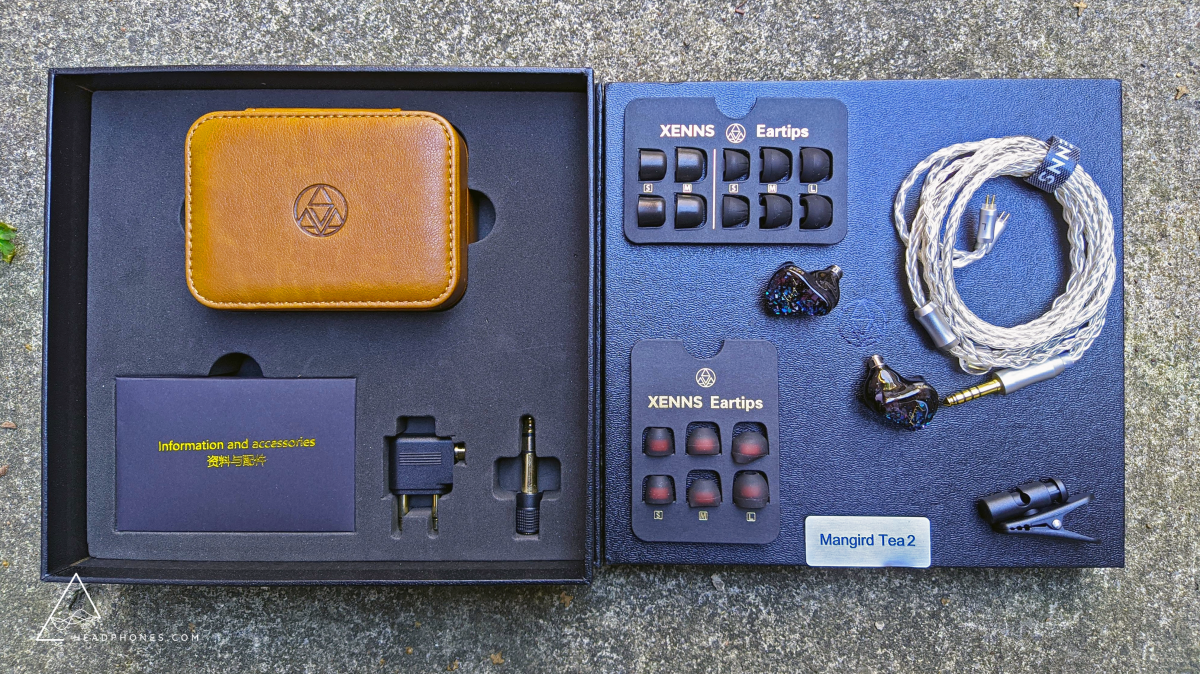XENNS Mangird Tea 2 Review: A Conventional Option

Review written by @Fc-Construct
Review unit provided by Linsoul
Introduction
Welcome back to another review of a ChiFi IEM with an incomprehensible name: The XENNS Mangird Tea 2 . It’s a $350 hybrid IEM with a 6 BA + 1 DD set-up and is the successor to the less strangely named Mangird Tea. I’m not sure where XENNS comes into play. Unfortunately, I haven’t heard the original Mangird Tea so no comparisons to that will be had in this article.
What’s in the Box?
Accessories for the Mangird Tea 2 are straightforward. You get a box style faux-leather carrying case and decent selection of tips: two different silicon S/M/L sets and a pair of S/M foam tips. Interestingly enough, they include an airplane adapter and quarter inch adapter. While the included cable is 2-pin, you can select between 2.5 mm, 3.5 mm, and 4.4 mm termination options. The stock cable feels about as good as any regular $20 3rd party cable you might buy so no real need for an aftermarket one.

The build of the Mangird Tea 2 is typical of IEMs, an ergonomically shaped full resin shell. There’s a small vent on the top of the shell, presumably for the DD. The faceplate is quite pretty with blue opalescent speckles on a black background. No complaints on the comfort. All in all, the Mangird Tea 2’s package is nothing special but gets the job done.
Frequency Response and Tuning
To be honest, I didn’t know what to expect when I first listened to the Mangird Tea 2. I typically try to avoid knowing anything about the stuff I review before I hear it if possible. My first impressions were quite positive. I was pleasantly surprised with the tuning. The bass is clearly boosted but not overdone. The midrange is warm thanks to a lower mids elevation and with an agreeable upper mids structure. The lower treble is recessed to make the Mangird Tea 2 a rather relaxing listen but has enough upper treble extension to give it a hint of sparkle. It’s nice. What isn’t as nice is its technical performance. It’s okay.

Frequency response of the XENNS Mangird Tea 2. Measurement taken with an IEC-711 clone microphone. Comparisons can only be made relative to other measurements taken by this specific microphone. A peak at about 8 – 10 kHz is likely an artifact of the measurement rig and may not exist as depicted here. Measurements above 8 kHz are not accurate.
Looking at the graph here, we can see a reasonable 5 dB boost in the bass, the shelf starting to slope slowly around the 250 Hz mark. The pinna gain started out good but skews upwards at 4 kHz which is rather unexpected as I don’t have much of an issue with it. The other part that was surprising was how much of a dip there was in the treble. The Mangird Tea 2 doesn’t feel nearly that dark to me. Overall, the tuning is best described as warm and mild.
Instrument Notes
Drums
The presence of the Mangird Tea 2’s DD is made most apparent in the drums. The notes of the kick and tom have a nice sense of weighty impact to them, an enjoyable amount of depth and oomph to nod your head along to. It’s characteristic of a bass shelf starting at 250 Hz. I don’t find the Mangird Tea 2 to be distinctly boomy nor punchy, taking a Goldilocks approach instead with a little bit of both thanks to the sloping bass curve. While bass texture is acceptable, the transients of the kick and toms are a little lacking. There is a slight blurring in the attack of each note. I have no complaints with the snare. There’s full body and a satisfyingly sharp crack to it, courtesy of that 4 kHz skew and upper treble extension.
The Mangird Tea 2 pulls back in the treble, making the hats and cymbals non-fatiguing. What’s notable is that they sound quite even without any awkward peaks or dips to break up the timbre. For how recessed it may seem on the graph, there’s a surprising amount of sparkle and presence here. Given the overall tuning of the Mangird Tea 2 as a mild, relaxed IEM, the hats and cymbals are well executed.

Guitars/Strings
There isn’t much to note here for the typical stringed representation of bass, acoustic, and electric guitars. Like the drums, bass notes do have a bit of that blurring going on where the transients aren’t quite sharp enough to render tight, punchy notes. Acoustic guitars have slightly lush with plenty of string clarity from the upper treble.
Vocals
As with the overall theme of the Mangird Tea 2, the vocals have a warm tilt to them. Half because of the bass curve and half because of the recessed treble gently subduing the natural airiness of the upper harmonics of voices. Make no mistake, however. There’s a lot of clarity in the vocals thanks the bountiful amount of upper mids present on the Mangird Tea 2. Vocals are reasonably forward and cut easily through the mix but are never shouty. Male and female vocals are equally balanced, neither outshining the other.

Presentation
The staging of the Mangird Tea 2 is a marginal step above the stereotypical closed-in IEM experience. The soundstage and imaging give a decent sense of space and instrument positioning to separate it from other lower end products that feel one-dimensional and closed in. The rest of the Mangird Tea 2’s technical performance can be similarly viewed in the same way. Compared to more budget orientated options, the Mangird Tea 2’s technical performance is an improvement. But against other IEMs of its class, it’s middling at best. While there is a sharpness to the transients of its treble notes, it does get muddled elsewhere by the bass which results in limited resolution. Note definition gives rise to reasonable instrument separation but there isn’t much in the way of layering.
Comparison to the MoonDrop Blessing 2 Dusk
 The MoonDrop Blessing 2 Dusk is the benchmark for IEMs looking to enter the mid-fi market. Doing an A/B comparison of the Mangird Tea 2 against the Dusk, it’s painfully clear that the Dusk is the better IEM. Simply put, it’s much more vivid and engaging than the Mangird Tea 2 is. Part of that of course is its tuning. The Dusk has quite a bit more bass and upper mids/lower treble than the Mangird Tea 2. The treble is crisper, mids are more forward, and the bass thumps harder. Where it gets really interesting is in its presentation. The analogy I’ll use is that the Dusk is like an OLED TV while the Mangird Tea 2 is like a regular IPS panel. There’s noticeably darker background on the Dusk which music is painted vividly upon than on the Mangird Tea 2 where music feels much more muted. While soundstage on the Dusk and Mangird Tea 2 are roughly the same, imaging and layering on the Dusk is undoubtedly stronger on account of much sharper positioning. The one area I’d say the Mangird Tea 2 potentially has an edge in is its treble. The Dusk has a lot of lower treble which creates a contrast as it trails off into the upper treble. In comparison, while the Mangird Tea 2’s overall subdued treble doesn’t have that same contrast, creating for a more even experience.
The MoonDrop Blessing 2 Dusk is the benchmark for IEMs looking to enter the mid-fi market. Doing an A/B comparison of the Mangird Tea 2 against the Dusk, it’s painfully clear that the Dusk is the better IEM. Simply put, it’s much more vivid and engaging than the Mangird Tea 2 is. Part of that of course is its tuning. The Dusk has quite a bit more bass and upper mids/lower treble than the Mangird Tea 2. The treble is crisper, mids are more forward, and the bass thumps harder. Where it gets really interesting is in its presentation. The analogy I’ll use is that the Dusk is like an OLED TV while the Mangird Tea 2 is like a regular IPS panel. There’s noticeably darker background on the Dusk which music is painted vividly upon than on the Mangird Tea 2 where music feels much more muted. While soundstage on the Dusk and Mangird Tea 2 are roughly the same, imaging and layering on the Dusk is undoubtedly stronger on account of much sharper positioning. The one area I’d say the Mangird Tea 2 potentially has an edge in is its treble. The Dusk has a lot of lower treble which creates a contrast as it trails off into the upper treble. In comparison, while the Mangird Tea 2’s overall subdued treble doesn’t have that same contrast, creating for a more even experience.

Should You Buy It?
Yes and no. The XENNS Mangird Tea 2 is an awkward IEM for me. On one hand, I did enjoy listening to it for this review. On the other hand, the IEM market has just gotten so competitive that the Mangird Tea 2’s technical chops are comparatively lacking. In a way, it reminds of the DUNU SA6. It’s an all-around pleasant IEM to listen to even if it doesn’t take home the price/performance crown. The difference however is the SA6 does have a couple technical tricks up its sleeve while the Mangird Tea 2 can at best be described as middling. All of this then begs the question: what if you don’t care that much about technical performance and simply want something that’s well tuned, comfortable, and easy-to-listen to? Then by all means, the XENNS Mangird Tea 2 may be for you.
